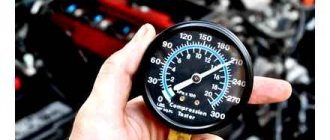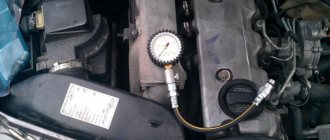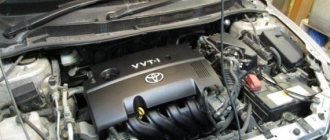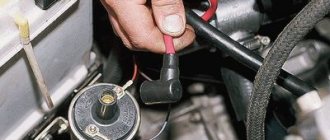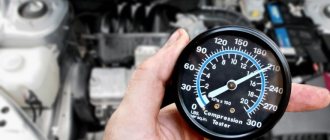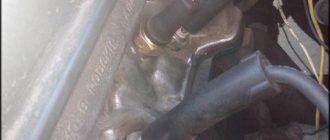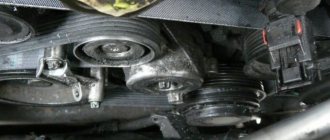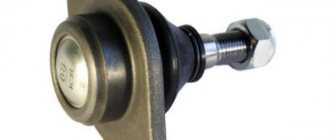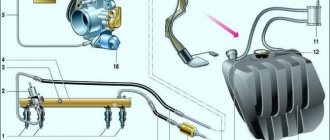Compression is one of the most important data characterizing the condition of a car engine. Indicates the pressure in the cylinder at the moment of compression. If the compression of the VAZ 2107 engine is below normal or its value varies in each cylinder, then it is necessary to immediately begin repairing the engine. For a VAZ 2107 car, the optimal pressure value is 12 atmospheres, and if the value is below 10 Bar, then the internal combustion engine needs repair.
Compression in a VAZ 2107 engine and methods for measuring it
Many car owners are aware that a lot depends on the compression in the VAZ 2107 engine. If this parameter is much lower than normal and, moreover, differs from cylinder to cylinder, then this indicates serious problems that need to be eliminated immediately. According to most experts, an excellent indicator for a new, well-run VAZ 2107 engine should be 12 atmospheres of compression. Of course, many motors do not have such parameters, but a value of at least 10 Bar would be quite normal.
What engine can be installed on a VAZ 2107 instead of the standard one?
Some car enthusiasts who are accustomed to upgrading cars with their own hands decide to replace the installed engine with a more productive one. Like any other car, the “Seven” can be converted and equipped with an engine from another car, but a number of rules must be followed:
- The replacement engine must exactly match the dimensions and weight of the standard device. Otherwise, there may be problems with the operation of the new motor.
- The new engine must be mated to the existing transmission.
- The power of the new power unit cannot be greatly overestimated (no more than 150 hp).
Motors from other VAZ models
Of course, first of all, the owners of the “Seven” turn their attention to the engines of other VAZ models. The best option (slightly more powerful and durable) is a carburetor with a VAZ 2114. It fully matches the dimensions of the VAZ 2107 carburetor, but is a more modern and productive device. In addition, you can install the engine from a VAZ 2114 with virtually no modifications - the only problems may arise with the RPD, but they are easily solved.
Motors from earlier VAZ models (2104, 2106) are also quite suitable in their dimensions and weight to replace the VAZ 2107 motor, however, replacement will not be advisable, since outdated devices will not give the car dynamics and durability.
Engines from foreign cars
The VAZ 2107 can also be equipped with an engine from an imported car. Power units from Fiat and Nissan brands are ideal for replacement. The whole point is that the progenitor of VAZ engines were Fiat engines, which also served as the basis for the development of Nissan engines.
Therefore, engines from these foreign cars can be installed on the “Seven” without any alterations or modifications.
Rotary engine
There was a period in the history of AvtoVAZ when some car models (including the Seven) were equipped with rotary piston engines. Initially, such installations were highly productive, but the VAZ 2107 with such engines had many disadvantages:
- high heat losses, due to which fuel consumption was higher than on conventional carburetor VAZ models;
- problems with engine cooling;
- the need for frequent repairs.
A new rotary engine can be installed on the VAZ 2107, but the design of the car itself will not allow for maximum optimization of all the capabilities of the car. Therefore, rotary engines are not popular among VAZ 2107 owners.
The procedure for measuring compression in cylinders of VAZ 2101-2107
So, before proceeding with a detailed description of this procedure, I would first like to provide a list of the necessary tools that will be needed for this work:
A compressor is a device that allows you to measure the pressure in the cylinders of an internal combustion engine on various automotive systems, ranging from diesel to gasoline power units. When choosing such equipment, it is very important to keep in mind that with a threaded fitting, the indicators will be somewhat more accurate than with a regular one (which has to be pressed during measurement). So it is best to use a threaded fitting. My Jonnesway compression gauge has both one and the other type. You can clearly see it in the photo below:
So, below is a detailed list of actions that must be performed to check the pressure in the cylinders. It is worth paying attention that the car engine must be warmed up, preferably to operating temperature, at least 70-80 degrees. After this, it is necessary to shut off the fuel line so that when the starter rotates, gasoline does not enter the combustion chamber. To do this, after installing the fuel filter, you can remove the hose and plug it with a bolt of the required size, for example, or simply clamp it, securing it with a clamp. And then start the engine and wait until it stalls on its own. Next, you need to unscrew all the spark plugs from 4 cylinders.
When you have dealt with this, you can screw the fitting of the device into the spark plug hole of the first cylinder of the VAZ 2107. Next, you will need an assistant who will sit in the cabin and use the key to turn on the starter, pressing the gas pedal completely. You need to turn the starter until the compression gauge readings stop increasing.
My Seven has an engine from a VAZ 2106 and when measured, the result was almost perfect, that is, 12 atmospheres in each cylinder. This is with a mileage of 75,000 kilometers after purchase.
If the values on your engines are at least 10 bar, then you can assume that everything is in order with your internal combustion engines, since this is quite normal for the “classic” Lada. Of course, you need to strive for 12, because this is practically the standard for such engines.
We carry out exactly the same actions with the remaining 3 cylinders and look at the pressure gauge readings. If the differences in different cylinders are more than 1 atmosphere, then there must be a reason for this and it must be eliminated. Either worn out piston rings, breakdown of the cylinder head gasket, violation of thermal valve clearances, etc.
How to check it yourself
Having a compression gauge and an assistant at hand, measuring compression will not be difficult.
- Warm up the engine to operating temperature.
- Shut off the fuel supply to the cylinders. For carburetor engines, disconnect the hose that goes from the carburetor to the fuel pump; for injection engines, remove the fuel pump fuse and let the engine run until the fuel is used up from the system.
- Disconnect all high voltage wires from the spark plugs.
- Unscrew the first spark plug and insert the compression gauge fitting in its place.
- Have a helper run the starter for a few seconds until the pressure gauge needle stops moving up.
- Take pressure gauge readings and compare them with standard values.
- Carry out the same procedure for all cylinders. Compare the compression ratios in the cylinders.
About compression of the VAZ 2107 - measurement and causes of reduced pressure
Compression is one of the most important data characterizing the condition of a car engine. Indicates the pressure in the cylinder at the moment of compression. If the compression of the VAZ 2107 engine is below normal or its value varies in each cylinder, then it is necessary to immediately begin repairing the engine. For a VAZ 2107 car, the optimal pressure value is 12 atmospheres, and if the value is below 10 Bar, then the internal combustion engine needs repair.
VAZ classic engine compression
- To the beginning of the forum
- Forum Rules
- Old design
- FAQ
- Search
- Users
In general, what are the standards for classics?
In general, what are the standards for classics? Is there some official document?
Strange, Logan 1.6 has 9.5 compression
Compression ratio is the ratio of the volume above the piston at BDC to the volume when the piston is at TDC. Dimensionless quantity, for example. 9, i.e. 9:1. Determined only by the geometry of the combustion chamber/cylinder and the piston stroke. Compression is the actual maximum pressure in the cylinder during the compression stroke. It strongly depends on the condition of the CPG and valves - that’s why it is measured to assess the condition of the engine. Compression (in atmospheres) is normally always greater than the compression ratio, since the gas increases its temperature during compression.
There are some approximate formulas for how to calculate the required amount of compression of an internal combustion engine at a known compression ratio, which can be found through Yandex.
In general, what are the standards for classics? Is there some official document?
No, let's think again. Otherwise this is a death sentence - repair! capital! I'll kill a friend with this. Maybe we can adjust the valves or something.
Measured with the throttle open. By the way, I remember that we measured it 2-3 years ago and it was also 10. Then for some reason it didn’t seem to alert anyone. Or could it be that he had 10 in his life? Although how will you find out now?
VAZ 2107 internal combustion engine compression standards
If there is a possibility of a motor malfunction, then the first thing you need to do is measure the compression ratio. To assess the condition of the CPG of a VAZ 2107 engine, you should first find out what values are considered normalized. What compression should be on a VAZ 2107 is a question that all owners of classics ask when they need to check the condition of the internal combustion engine.
The higher the pressure during compression of the fuel-air mixture in the combustion chamber, the better. The standard pressure value when compressing fuel assemblies in cylinders on a VAZ 2107 is 10-12 atmospheres. But this indicator is not appropriate for all engines. As you know, sevens were produced not only with carburetor, but also with injection types of engines. For carburetor and injection internal combustion engines, the lower threshold is 10 atmospheres or 1 MPa. The engine is considered to be in excellent condition if the pressure gauge shows a value of 13 Bar (this happens with new engines). A run-in working motor has a pressure value of approximately 12 bar.
What engines is the VAZ 2107 equipped with?
The VAZ 2107 model was produced from 1982 to 2012. Over the 30 years of its existence, the car has been repeatedly refined and changed to more accurately meet modern requirements. Initially, the “seven” was conceived as a small-class rear-wheel drive car in a sedan body. However, in some countries the VAZ 2107 was refined and modified, which is why it can be considered a universal car model.
Depending on the year of manufacture and the country of origin (at different times, the VAZ 2107 was produced not only by the Russian AvtoVAZ, but also by factories in European and Asian countries), the model was equipped with different types of propulsion systems:
- LADA-2107 (engine 2103, 1.5 l, 8 cells, carburetor);
- LADA-21072 (engine 2105, 1.3 l, 8 cl., carburetor, timing belt drive);
- LADA-21073 (engine 1.7 l, 8 cells, mono injection - export version for the European market);
- LADA-21074 (engine 2106, 1.6 l, 8 cl., carburetor);
- LADA-21070 (engine 2103, 1.5 l, 8 cl., carburetor);
- LADA-2107–20 (engine 2104, 1.5 l, 8 cells, distributed injection, Euro-2);
- LADA-2107–71 (engine 1.4 l, 66 hp, engine 21034 for A-76 gasoline, version for China);
- LADA-21074–20 (engine 21067–10, 1.6 l, 8 cl., distributed injection, Euro-2);
- LADA-21074–30 (engine 21067–20, 1.6 l, 8 cl., distributed injection, Euro-3);
- LADA-210740 (engine 21067, 1.6 l, 53 kW/72.7 hp 8 cells, injector, catalyst) (2007);
- LADA-21077 (engine 2105, 1.3 l, 8 cl., carburetor, timing belt drive - export version for the UK);
- LADA-21078 (engine 2106, 1.6 l, 8 cl., carburetor - export version for the UK);
- LADA-21079 (rotary piston engine 1.3 l, 140 hp, originally created for the needs of the Ministry of Internal Affairs and the KGB);
- LADA-2107 ZNG (engine 21213, 1.7 l, 8 cells, central injection).
That is, in total there were 14 versions in the VAZ 2107 line - either with carburetor engines or with injection ones.
Technical characteristics of VAZ 2107 (carburetor)
The VAZ 2107 was initially equipped with a 1.5 and 1.6 liter carburetor. In the USSR in the 1980–1990s, almost all produced models were equipped with engines of this size - this power was quite enough for trips around the city and country roads. The engine uses AI-92 gasoline to create the air-fuel mixture. There were also 1.3 and 1.2 liter carburetors, but they were not particularly popular.
2.4. Compression check
Checking the condition of the engine can be done by measuring the compression in the engine cylinders. If this check is carried out regularly, then you can find out in advance the beginning of engine wear, without waiting for the moment when wear manifests itself in low engine efficiency.
Warm up the engine to operating temperature. In this case, the battery must be fully charged. Remove the spark plugs.
Disconnect the ignition system by disconnecting the low voltage supply wire (+ 15) from the ignition coil.
Install a compression gauge into the spark plug hole of the first cylinder.
An assistant must press the accelerator pedal all the way and crank the engine with the starter. After turning the crankshaft one or two revolutions, the compression pressure should increase to a maximum and then stabilize. Record the maximum result obtained.
Lada 2107 › Logbook › Compression measurement and purchase for the future
Hi all! I purchased a little in advance for the upcoming weekends and holidays. It turned out to be a whole box. In fact, I planned to carry out some of the work on the weekend, but the weather was somewhat disappointing. Either snow, or cold, or even the Olympics.
I noticed a strange thing: the holes for the cylinders in the cylinder head gasket are not round in shape
. Either it’s a defect (although it doesn’t look like it: it’s done quite well), or it’s just how it was intended. Can someone tell me?
Still, I couldn’t resist checking the compression.
It turned out 11 kgf/cm^2 with the exception of the first and fourth cylinders. There were 10.2. If you believe the operator's manual, then, in principle, both the value itself and the deviation between the cylinders are within normal limits. It is possible, and most likely, that this is due to poorly adjusted valves. However, adjustment with a feeler gauge is not as accurate as adjustment with a device. It may not be necessary to replace the cylinder head gasket. To be honest, I seriously doubt that if I go there, I’ll just limit myself to replacing the gasket, and do something else “along the way” as usual)) Checking with a compressor will tell. I didn’t have time to check with oil for the presence of the rings - it started snowing heavily.
If anyone needs it, the algorithm for measuring compression: 1. Warm up the engine to operating temperature. 2. Remove all spark plugs. It is better to hang the ends of high-voltage wires so as not to touch them. I got screwed once due to my inexperience. How many years have passed, I still remember and even feel it in places)) 3. Insert (if the compression gauge is plug-in, as in my case) or screw the tip of the compression gauge into the spark plug hole of the cylinder being tested. 4. Ask an assistant to press the accelerator pedal all the way or fix it (the pedal) in any available way. I used a board inserted into the spacer between the seat and the pedal. A prerequisite is a full throttle opening, as well as a neutral position of the gearshift handle, a charged battery and a tightened handbrake. 5. Turn the crankshaft with the starter (about 3-5 seconds at a time) until the compression gauge readings stop increasing. In principle, you can turn it with a key using the pulley. 6. It is better to record the received readings and repeat the test if necessary. 7. Reset the device readings by pressing the button on the end or unscrewing the tip, as in my case. 8. p.p. Repeat steps 3-7 for the remaining cylinders.
Actually, that's all. The main thing is not to forget to screw in the candles later. And then one person swore that I broke his car, it won’t even start now))) And by the way, to check the compression rings you need to pour a little engine oil into each cylinder, about the size of a spoon. And measure the compression again. If the compression increases after this, then the problem is in the rings, or in the rings and cylinder head gasket. Thank you for your attention!
Compression and compression, what's the difference?
In everyday life, when we talk and say compression, we mean compression; in reality, they are not the same thing. So what is the difference between compression ratio and compression?
The most obvious way to prove this is a mathematical calculation. Look at the figure below as you can see from here that the compression ratio in the simplest interpretation of the formula is the ratio of the working volume to the volume of the combustion chamber.
In reality, for a more accurate measurement, the formula looks like this:
where v3 is the volume of the compression meter. For the calculation, the coefficient 1.2 ‒ 1.3 is used (determined by the Poisson equation) and the formula has the form P=ε*1.2. From here we have that with a compression ratio of 10 kg/cm 2, the compression should be in the range of 12-13 kg/cm 2. Ideally, the values obtained by the compression meter should coincide with the calculated ones.
Compression measurement results
The results of compression measurements show the condition of the engine, in particular the pistons, piston rings, valves, camshafts, and allow decisions to be made about the need for repair or just replacement of the head gasket or valve stem seals.
Compression pressures for different engine types
On gasoline engines, normal compression is in the range of 12-15 bar. If we take a closer look, the trend will be as follows:
- front-wheel drive domestic cars and old foreign cars - 13.5-14 bar;
- rear-wheel drive carburetor – up to 11-12;
- new foreign cars are 13.7-16 bar, and turbocharged cars and with a large volume up to 18 bar.
- in the cylinders of a diesel car, the compression should be at least 25-40 atm.
Standard for different engines
The pressure in the engine cylinders depends on its type. The compression in a diesel engine should be no lower than 28 kg/cm2, although in earlier domestic models a pressure of 20 kg/cm2 was considered normal, while the spread of values between the cylinders should be no more than 2-3 kg/cm2.
On most gasoline imported and domestic cars, normal engine compression should be within 10 - 13 atmospheres, including on the VAZ 2107, and on VAZ models of the “tenth” family it is slightly higher, from 11 atmospheres. The compression difference in the cylinders should be no more than 0.5-1 kg/cm2.
Where is the engine number
Each vehicle model produced at the factory is equipped with an engine with a personal number. So, the engine number on the “seven” is its identification number, which can be used to determine the identity of the stolen car and its history.
The engine number is stamped on the cylinder block on the left side, immediately below the distributor. In addition, the number is duplicated in the summary table, which is attached below the air supply housing. The metal plate contains information about the car, such as model, body number, model and number of the engine unit, equipment, etc.
Signs of poor compression
Friction between the piston with rings and the cylinder leads to an increase in the gap, and as a result there will be:
- increased oil consumption, as it will be poorly collected by oil scraper rings and burn in the combustion chamber;
- increased amount of smoke due to burning oil, which follows from point 1 (in some cases this may be due to faulty valve stem seals);
- As a result, power decreases. This drop will be especially noticeable on small displacement engines;
- increased amount of smoke from the breather. The breather is available on both carburetor and injection models.
What affects engine compression
- Throttle position . When the throttle is closed or covered, the pressure decreases
- Air filter dirty.
- Incorrect valve timing when the valve closes and opens at the wrong times. This happens when the belt or chain is installed incorrectly.
- The valves do not close on time due to gaps in their drive.
- Motor temperature . The higher its temperature, the higher the temperature of the mixture. Therefore, the pressure is lower.
- Air leak . Air leaks reduce compression. They are caused by damage or natural wear of the combustion chamber seals.
- Oil entering the combustion chamber increases compression.
- If fuel enters in the form of droplets , then compression is reduced - the oil, which plays the role of a sealant, is washed off.
- Lack of tightness in the compression gauge or check valve.
- Crankshaft rotation speed . The higher it is, the higher the compression; there will be no leaks due to depressurization.
The above describes how to measure compression in an internal combustion engine running on gasoline. In the case of a diesel engine, measurements are made differently.
Reasons for low compression
As mentioned above, a decrease in compression occurs for several reasons, these are:
- engine service life;
- violation of maintenance (delayed oil change);
- use of low-quality oil;
- engine overheating;
- Driving with a cold engine (thermostat malfunction).
There are also reasons when additives will not help and repairs are needed, these are:
- piston burnout;
- valve burnout;
- burnout of the gasket between the cylinders;
- rings are stuck (sometimes “cured”).
Faults such as burnout are almost immediately noticeable, but some can only be determined after diagnosis.
The higher the compression, the better: the fourth tale
Often, from apologists for various additives, you hear how the compression jumped after the next treatment of the engine. Growth up to 15 bar, up to 17 bar! But we must keep in mind that in normal condition, even after restoring the gaps to the state of a new engine, you will not get compression higher than standard.
Where do the numbers come from? Usually, on a disassembled engine, it is clear that after processing the combustion chamber is overgrown with something unknown and, as a result, the volume of the compression chamber has decreased. But these deposits interfere with heat removal from the combustion chamber. Hence detonation, glow ignition, etc. So we shouldn’t rejoice at the unprecedented increase in compression, but vice versa.
Change in specific fuel consumption at fixed speeds (2500 rpm) in two engine variants - basic and with rings in which the gaps are increased. Compression has dropped, but in terms of consumption this is noticeable only at low loads.
Source
Engine diagnostics
If the piston burns out, the tightness in the cylinder is broken, the engine starts poorly and runs unevenly, just like with a burnt out valve. The engine does not start well (or even does not start) when the rings are stuck.
Checking without a device
You can check compression without a compression gauge. If you need to identify which cylinder is faulty, then just unscrew the spark plugs and crank the engine with the starter, and by closing the holes with your finger, control the process of air intake and release. If there is a major malfunction (a burnt-out piston or valve), you will identify this cylinder immediately, since it will be less able to suck in and push out air.
Compression measurement in carburetor engine cylinders
The procedure given in the article and recommendations for measuring compression in cylinders are applicable for gasoline carburetor engines of VAZ passenger cars - 2108, 21081, 21083, 2109, 21091, 21099, 2101, 2106, 2105, 2107, 21021, 210213, 1111 and a number of others similar (Moskvich, Izh, Volga...).
Measuring compression on injection engines has a number of features and will be discussed in a separate article. Before tuning and adjusting the carburetor of your car, you should take into account the general condition of the engine, since the symptoms of a number of its malfunctions can be mistakenly considered symptoms of carburetor malfunctions. For example, unstable idling or difficult starting may indicate not only problems in the idle or carburetor starting system, but also that one of the valves in the engine is burnt out, the head gasket is broken, the piston rings are worn out or stuck, etc. By measuring the compression, we will more or less accurately determine the condition of the engine and identify possible malfunctions in its operation. After eliminating them, you can safely adjust the carburetor.
Tools and devices for measuring compression
Preparatory work
1. Warm up the engine to operating temperature (80-90º).
2. Remove the fuel supply hose from the fuel pump.
3. We unscrew all the spark plugs, having first cleared their wells of dirt and debris.
4. Remove the central armored wire from the distributor cover, insert the spark plug into it and place it on the engine.
5. Screw the tip of the compression gauge into the hole of the first cylinder, or press it firmly against this hole.
Measuring compression in carburetor engine cylinders
Recovery methods
To increase the compression in the engine, if you are sure or suspect that the rings are stuck, you can pour 100 grams of clean oil into each and give them time to “throw away”. Sometimes turning the crankshaft in both directions a few degrees. The procedure can be repeated.
The second, more effective method, you need to take: 1 part clean motor oil, 1 part acetone and 1 part kerosene. Stir and pour 50 ml into each cylinder, tighten the spark plugs and leave for 10 hours. Unscrew the spark plugs and crank the engine with the starter for a few seconds. We install the spark plugs, start it and heat it up to 40 degrees no more. Drain the oil, flush the system, change the filter and fill in new oil.
There are also special means that are also used to combat increased compression, which occurs when there is more carbon deposits on the piston and in the combustion chamber.
The second method is to restore pressure by adding additives to the oil. There are quite a lot of them on the market with varying effectiveness. I wrote about the use of the Suprotek additive, the effect of its use is positive.
The concept of compression, its measurements
There is no such characteristic among the technical data specified in the vehicle’s operating manual. There is a slightly different concept - compression ratio. There is no direct relationship between these two parameters; they are united by only one thing - in both cases we are talking about pressure.
- The compression ratio is a calculated constant value; it has no dimensional units. For the VAZ 2106 engine and its modifications it is 8.5. This figure is the result of dividing the total working volume of the cylinder by the volume of the combustion chamber. In simple words, the air-fuel mixture entering the cylinder space is compressed 8.5 times by the upward moving piston.
- Compression is a variable value; its value depends on the technical condition in which the engine is located. This parameter shows what pressure occurs in each individual cylinder when the crankshaft rotates using the starter. It is measured with a pressure gauge, which is screwed in instead of a spark plug, the unit of measurement is 1 kgf/cm2 or 1 Bar, which is almost the same thing (1 kgf/cm2 is equal to 0.98 Bar).
Compression is measured to determine the degree of wear of the cylinder-piston group. Its values were obtained experimentally, in practice. The measurement is performed as follows: all 4 spark plugs are unscrewed, and in their place, a pressure gauge with a check valve is screwed into each cylinder one by one, and by rotating the starter, the maximum pressure that can be pumped by each piston is determined. In the VAZ 2106 engine, the ideal figure is 13 kgf/cm2, but this is a rare case; such pressure is found on new, only run-in engines.
Why do you need to check?
It is recommended to measure compression at least once every 15-20 thousand kilometers . Its deviation to a lesser extent leads to the fact that the fuel mixture is not compressed to the required level and ignites at a slower rate, as a result of which the engine overheats and its power is significantly reduced.
Increased compression, on the contrary, causes early ignition of the mixture, as a result of which it detonates, creating additional loads on the piston elements.
If there is a difference in compression in the cylinders of one engine, the mixture will ignite at different rates, creating an imbalance in the coordinated operation of the pistons and camshaft(s).
What does low compression lead to?
Most often, compression in the cylinders does not increase, but decreases. This may be a consequence:
- wear or damage to compression rings;
- wear or burnout of valves;
- damage to the cylinder head gasket;
- cracks in the cylinder head.
These problems can cause:
- reducing engine power;
- deterioration of dynamic performance;
- increased fuel consumption;
- “forcing” oil into the air filter housing (in carburetor engines);
- oil getting inside the combustion chambers (the engine “eats” oil, which is characterized by bluish exhaust smoke).
If you find the listed signs in your car, be prepared to at least replace the piston and, at maximum, overhaul the engine. But before you start repairing it, you should make sure that the compression is really low.
Compression and compression ratio are the same thing: the first fairy tale
No not like this! Compression is the pressure in the cylinder, the compression ratio is a dimensionless parameter that describes the geometric parameters of the cylinder: it is the ratio of the total volume of the cylinder to the volume of the compression chamber (the compression chamber is the volume of space above the piston at its position at TDC (it is also called the volume of the end of compression - this is the same thing). Calling it a combustion chamber is incorrect, since fuel combustion occurs throughout the entire volume of the cylinder.) Compression depends on the compression ratio, but the compression ratio does not depend on compression! Compression also depends on a bunch of parameters: compression start pressure, valve timing adjustment, temperature at which the measurement is carried out, leaks from the combustion chamber. And leaks are determined by wear of the rings and cylinders.
How and what to measure
Compression is measured with a special device - a compression meter. It is a pressure gauge with a hose, at the end of which there is a fitting, either metal with a thread for a spark plug hole, or rubber in the form of a cone.
The process of measuring compression using a compression gauge involves placing a fitting in the spark plug hole and cranking the crankshaft with the starter until maximum pressure is reached.
Compression in a cylinder can also not be measured, but checked and compared with other cylinders.
To do this, unscrew all the spark plugs except one, and manually (using a wrench on the generator pulley nut) turn the crankshaft until the piston reaches top dead center.
Then they check the second cylinder, the third and the fourth in the same way, and compare the applied forces. Of course, this method is not comparable to measuring with a compression gauge, but it can help to understand which cylinder has a problem.
What should the compression be in VAZ cars?
The average compression rate for unboosted VAZ engines is 8-9 atmospheres, for forced ones with a reduced combustion chamber - 11-13 atmospheres.
In order to accurately determine the standard compression ratio, use the table that indicates the compression ratio in the cylinders of eight- and sixteen-valve VAZ engines.
Sources:
https://zarulemvaz.ru/kompressiya-v-dvigatele-vaz-2107-i-sposoby-ee-izmereniya/ https://provaz07.ru/dvigatel/kompressiya-v-vaz-2107.html https://automn .ru/vaz-2107/vaz-16633-10.m_id-713.m_id2-1656.html https://znatokvaz.ru/dvigatel/kompressiya-dvigatelya-i-proverka https://mylada.net/nachinayushhemu-avtomexaniku /kak-proverit-kompressiyu-dvigatelya.html
Why does compression drop?
A drop in pressure can be caused by various reasons. Some of them can be easily fixed, while others you cannot cope with without specialists. The main factors causing lack of compression are:
- Worn spark plugs. The most innocent reason that anyone who has ever looked under the hood will win. See the article "Signs of Bad Spark Plugs";
- It's time to change the gasket in the cylinder block. You can’t do this on the road, but when you get home, it’s a completely manageable repair on your own;
- valve problem. They may need adjustment if they have gaps. It is much worse if one of the valves burns out or its seat is destroyed;
- The piston rings have failed. Alas, alas, we take out our stash and remember the phone number of a good auto mechanic we know.
Even if you come across the worst case, after measuring the compression you will at least know which cylinder failed you.
